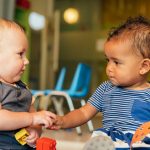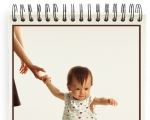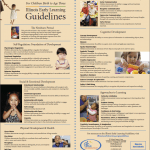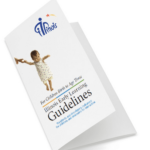In the first few years of life, children depend on their caregivers to keep them safe and healthy for proper development. Children are beginning to grow in their capacity to recognize potentially unsafe or unhealthy situations, but will need a lot of caregiver support. Children build this capacity by establishing trust in responsive and nurturing caregivers who are consistent in meeting their needs. Children also look to their caregivers to establish what is acceptable and what is not.
At birth, children are not completely defenseless. They enter the world with a set of reflexes designed to signal basic survival needs to caregivers.1 As they grow, children become aware of their own bodies and their environment. They become purposeful in how they interact with their environment and actively practice all the new skills they develop. The challenging aspect is finding the right balance of active exploration and learning, and keeping children safe in their environment.
With new skills come risky behaviors that are developmentally appropriate. Children lunge forward with no regard for anything in their way, or pick up everything possible off the floor and place it in their mouths. Children do not have the ability to control their impulses, and will test safety limits that have been put in place by caregivers. Children’s growing cognitive abilities help them process why safety rules are in place, along with building memory for what is allowed and what is not. While they may pay attention to safety rules, children still need constant supervision to stay safe.
Keeping Children Safe
The concept of “No” is used often by caregivers in the first three years. “Don’t touch,” “Stop,” “No hitting,” are all part of daily interactions with toddlers. Young children are unable to control their impulses; therefore it is important for caregivers to have realistic expectations of children when it comes to their understanding what is safe or what is unsafe. Safety in the first three years is very important, and caregivers work tirelessly to ensure that children are well taken care of and safe. During this period, constant supervision, consistent care, and redirection are what support children in staying safe. While children are building their cognitive capacities to understand what they can and cannot do, they are not able to control their actions. Caregivers often find themselves repeating the same words and actions over and over, and while it may be frustrating, young children need those constant reminders. Children’s ability to remember is still developing, and they rely heavily on structure, routines, and consistency to build their understanding of safety and well-being.
Birth to 9 months
Children first rely on their natural reflexes to signal basic survival needs to their caregiver(s). Toward the end of this age period, an emerging awareness in their own bodies and trust in their caregiver(s) support children in meeting needs and protecting them in uncertain and potentially unsafe situations.
Indicators for children include:
- Signals needs through reflexes and sounds, e.g., demonstrates rooting reflex when hungry, cries when uncomfortable
- Actively observes and explores environment
- Demonstrates interest in own body, e.g., stares at hands, mouths feet, pokes at belly button
- Uses physical movements to explore environment, e.g., reaching, sitting, rolling
- Demonstrates trust in caregiver(s), e.g., reaches for adult, comforted when soothed, looks for caregiver in novel situations
Strategies for interaction
- Meet the child’s needs in a prompt and sensitive manner
- Respond thoughtfully when interacting with the child
- Provide a safe, child-proof environment, while providing constant supervision
- Soothe and comfort the child as needed, e.g., hold, cuddle, rock
- Interact with the child; sit on the floor with the child and engage in exploration and play
7 months to 18 months
Children’s increasing physical abilities allow them to explore new ways of interacting with the environment around them. Motivated by these new skills, children take risks to explore and learn, and demonstrate through nonverbal and verbal communication trust in their caregiver(s) to keep them safe.
Indicators for children include:
- Uses social referencing to assess uncertain situations, e.g., looks at a caregiver for social cues as to whether or not to proceed
- Actively climbs to reach for wanted objects during play
- Responds to cues from caregiver in uncertain and unsafe situations
- Hesitates and demonstrates caution in new and/or changing situations, e.g., stops crawling when reaches the edge of an uneven surface
- Responds to warnings and changes in tone of voice; needs assistance and redirection to stop unsafe behavior, e.g., looks up after hearing a stern “no” but does not necessarily stop the behavior or action
Strategies for interaction
- Use facial clues and gestures to communicate to the child in uncertain situations, e.g., nod head yes, and smile to encourage the child to crawl toward the new toy
- Establish boundaries and limits; remain consistent and firm
- Provide a safe, child-proof environment, while providing constant supervision
- Explain to children why certain rules are in place
16 months to 24 months
Children begin to build a basic understanding of their physical limits and unsafe situations. Children are still motivated to interact and explore the environment with little regard to risks and continue to rely on caregiver(s) to help manage their impulses.
Indicators for children include:
- Understands when “no” and “stop” is communicated through either words or gestures
- Responds to warnings and begins to change behavior accordingly, e.g., moves away from the outlet after caregiver communicates “no”
- Seeks comfort when fearful
- Imitates adults’ actions during play, e.g., tells baby doll “no touch” when walking by the pretend stove
Strategies for interaction
- Provide a safe, child-proof environment, while providing constant supervision
- Model safe practices and behaviors for the child, e.g., do not stand on chairs when attempting to reach for objects
- Support the child in new situations; allow him or her time to warm up to new people, objects, and activities
21 months to 36 months
Children will begin to demonstrate a limited ability to internalize what caregiver(s) communicates in relation to safety, rules, and well-being. Children continue to act upon impulses but begin to develop strategies to protect themselves in uncertain and potentially unsafe situations.
Indicators for children include:
- Pays attention to safety rules but still needs supervision to keep self safe
- Communicates to an adult if something is wrong, e.g., a peer is hurt or missing
- Remembers and begins to apply past experiences to future situations, e.g., walks carefully and slowly when there is snow on the ground
- Reminds younger peers of rules, e.g., holds hands with a younger peer while walking outside
Strategies for interaction
- Provide constant supervision and guidance
- Talk with the child about unsafe situations and what he or she should do to get help
- Respect the child’s expressed fears
- Establish boundaries and limits; remain consistent and firm
Keep In Mind
Child development does not occur in isolation; children reach their developmental milestones within their social and cultural contexts. However, while “how the child develops” may look different, “what the child develops” can be observed in a more universal fashion. Below are some indicators that may warrant a discussion with the child’s healthcare provider for closer examination.
- Does not display object permanence by 12 months of age
- Does not babble, point, or make meaningful gestures by 12 months of age
- Does not know the simple functions of common objects, e.g., a cup, telephone, by 24 months of age
- Does not engage in symbolic play by 36 months
Notes
- Brazelton, T. B. (1992). Touchpoints: Your child’s emotional and behavioral development. New York: Perseus.
Discover how Safety & Well-Being is related to:
- Self-Regulation: Foundation of Development
Attention Regulation - Self-Regulation: Foundation of Development
Behavior Regulation - Developmental Domain 1: Social & Emotional Development
Attachment Relationships - Developmental Domain 2: Physical Development & Health
Self-Care - Approaches to Learning
Confidence & Risk-Taking


 Printer-friendly PDF
Printer-friendly PDF








 PDF para imprimir
PDF para imprimir